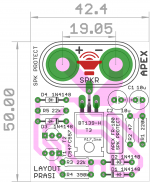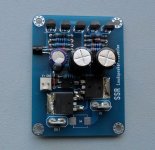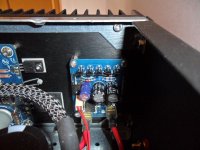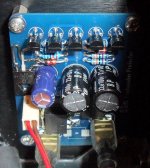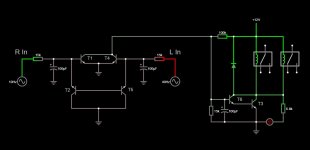Hmmmm , Been 'doing this' Audio stuff since mid 60's, even DIY'ing a TT 'back then'
Frankly I've NEVER owned a Protection circuit.. or gear that included it.
Also never ever blown out a speaker either.. over the almost 50 years preceding.
Clearly then I don't know what I've been missing
Some notable designers suggest that designing a decent protection circuit is Far more difficult than designing a worth owning Amp design.. so they Don't.
Sooo a 5 $ Chi Fi ebay 'thing' is wonderous..is it Really?
Frankly I've NEVER owned a Protection circuit.. or gear that included it.
Also never ever blown out a speaker either.. over the almost 50 years preceding.
Clearly then I don't know what I've been missing
Some notable designers suggest that designing a decent protection circuit is Far more difficult than designing a worth owning Amp design.. so they Don't.
Sooo a 5 $ Chi Fi ebay 'thing' is wonderous..is it Really?
I doubt that. Even Chipamp products, which you have extolled the virtues of in the past, have integrated protection circuits and external or internal muting circuits that combine to protect against misuse and accidental overload. Without some form of shorting protection at least, manufacturers would be liable for all sorts of claims, bans and legal action.....Frankly I've NEVER owned a Protection circuit.. or gear that included it......
As DIYs, we take this liability on ourselves, just as I have too for even more years since I started on this adventure. Mostly through care and the advice of wiser heads, I haven't done much damage this way either but it remains all too easy for us to destroy discrete output stages and speakers, just by hot swapping leads, using uninsulated connectors or fitting protection circuits that may never be set up or tested properly for their effectiveness in the particular application.
As consumers too, we simply rely on commercial safety standards to keep our systems working and safe. As DIYs though, we use our products in much the same way so we can't just assume that anyone else who touches our gear will be aware of its lack of protection and what that means in use. If you ever notice how attracted small (and large
Yes 0.0025% is very low.
Doug's comment has only statistical relevance (five times more distortion which happens to be only 0,0025%!), or may be is intended as some kind of joke. That is not serious reason for not using output cap.
A protection circuit should never be solicited which may most, may least.
Putting a well-studied protective circuit should be systematic and can save our dear speakers, otherwise it remains only our eyes to cry and say "if I knew!".
It is only my humble opinion.
Putting a well-studied protective circuit should be systematic and can save our dear speakers, otherwise it remains only our eyes to cry and say "if I knew!".
It is only my humble opinion.
Last edited:
Putting a well-studied protective circuit
We should talk about sensivity of the DC detection (too late is catastophic and too early is annoying) and it highly depends on a lot of factors.
In that case, it should be interesting to establish few profiles of loudspeakers in order to adapt a circuit to all scenarios.
Last edited:
Welcome pcb maker.how about a crowbar protection that is transparent to output?
I would prefer this as an add together with a protection circuit.
Is it a tested circuit?
What is the amplifier minimum rail voltage that can be used?
This can be used only when rail fuses used.
BTW can you share the pcb?
Hi thimios,
its shared here, http://www.diyaudio.com/forums/solid-state/173462-studio-reference-amplifier-222.html#post4837066
its an Apex design, I havent tested, just designed. he says, activated with DC >+/-10V.
here is the sch.
http://www.diyaudio.com/forums/solid-state/173462-studio-reference-amplifier-215.html#post4823420
its shared here, http://www.diyaudio.com/forums/solid-state/173462-studio-reference-amplifier-222.html#post4837066
its an Apex design, I havent tested, just designed. he says, activated with DC >+/-10V.
here is the sch.
http://www.diyaudio.com/forums/solid-state/173462-studio-reference-amplifier-215.html#post4823420
Hi thimios,
its shared here, http://www.diyaudio.com/forums/solid-state/173462-studio-reference-amplifier-222.html#post4837066
its an Apex design, I havent tested, just designed. he says, activated with DC >+/-10V.
here is the sch.
http://www.diyaudio.com/forums/solid-state/173462-studio-reference-amplifier-215.html#post4823420
It is only my modest POV and totally subjective but... IMHO a speaker protection without any galvanic isolation is a mistake.
Some notable designers suggest that designing a decent protection circuit is Far more difficult than designing a worth owning Amp design.. so they Don't.
Examples? Quotes? Other relevant stuff might (though I doubt it) be interesting.............
Hi thimios,
its shared here, http://www.diyaudio.com/forums/solid-state/173462-studio-reference-amplifier-222.html#post4837066
its an Apex design, I havent tested, just designed. he says, activated with DC >+/-10V.
here is the sch.
http://www.diyaudio.com/forums/solid-state/173462-studio-reference-amplifier-215.html#post4823420
Thanks,so this is suitable for any amplifier that operate at any power supply from +\-10v
The dc offset that activate the triac is another thing.
This circuit haven't any reference to GND, no isolation needed.
Last edited:
Hi thimios,
its shared here, http://www.diyaudio.com/forums/solid-state/173462-studio-reference-amplifier-222.html#post4837066
its an Apex design, I havent tested, just designed. he says, activated with DC >+/-10V.
here is the sch.
http://www.diyaudio.com/forums/solid-state/173462-studio-reference-amplifier-215.html#post4823420
Thanks,so this is suitable for any amplifier that operate at any power suplly from +\-10v
The dc offset that activate the triak is another thing.
Even 10x 0.0025% is fine if done right.Doug's comment has only statistical relevance (five times more distortion which happens to be only 0,0025%!), or may be is intended as some kind of joke. That is not serious reason for not using output cap.
Hello everyone
Here is the prototype under test of my SSR protection.
Normally when fully optimized it can be powered from 12V to 50V without matching component values (just a small current setting on a trimmer). The DC detection can be selected from +/- 0.6V to a higher value if desired.
Currently I have a small problem to solve on the start-up delay.
Here is a picture of the protype that works without any worries on my amplifier class A (USSA-5 by Fab).
Regard's
Here is the prototype under test of my SSR protection.
Normally when fully optimized it can be powered from 12V to 50V without matching component values (just a small current setting on a trimmer). The DC detection can be selected from +/- 0.6V to a higher value if desired.
Currently I have a small problem to solve on the start-up delay.
Here is a picture of the protype that works without any worries on my amplifier class A (USSA-5 by Fab).
Regard's
Attachments
Hello everyone
Here is the prototype under test of my SSR protection.
Normally when fully optimized it can be powered from 12V to 50V without matching component values (just a small current setting on a trimmer). The DC detection can be selected from +/- 0.6V to a higher value if desired.
Currently I have a small problem to solve on the start-up delay.
Here is a picture of the protype that works without any worries on my amplifier class A (USSA-5 by Fab).
Regard's
Very interesting!
I have used these XY boards in various amplifiers. I had one in a TPA3116 amp and found that at a reasonable volume level (not mega loud) there was a noise which is hard to describe. It was like there was poor connection in the signal line, a sort of electrical interference. If I backed off the volume slightly it disappeared. I put this down to the 3116 perhaps getting too much signal or it was not happy in some way.
I have just put together another Class D amp (TK2050) form a board I have had lying around for a few years and added the XY protection board. I had tested the amp without the protection board and it was fine, it played to silly levels without distortion. After I added the protection board it did the same as with the 3116 board. Anyone have any ideas what is going on?
I have just put together another Class D amp (TK2050) form a board I have had lying around for a few years and added the XY protection board. I had tested the amp without the protection board and it was fine, it played to silly levels without distortion. After I added the protection board it did the same as with the 3116 board. Anyone have any ideas what is going on?
it may be something like that https://cdn.shopify.com/s/files/1/1006/5046/files/Speaker_Protection_Board_Schematic.jpg
- Home
- Amplifiers
- Solid State
- Speaker Protection Kit for under $5
